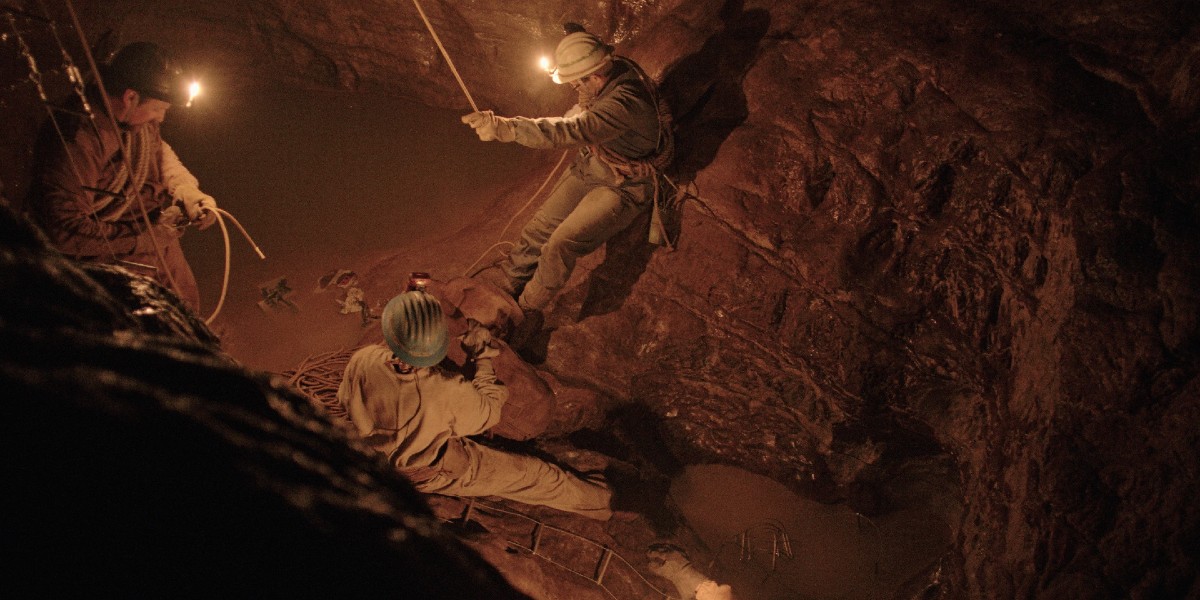Near the town of Cerchiara, in a valley nestled within the Pollino massif of mountains on the border between the Calabria and Basilicata regions of lushest Italy, there is a hole. It’s not the biggest hole, but at the time of its exploration, it was the second-deepest. In the summer of 1961, a team of speleologists in from Turin plumbed the depths of what would be known as the Bifurto Abyss, and did so largely without incident. Though they wedged themselves into spaces tightly confined enough to give claustrophobes sympathy panic attacks, there was no cave-in, no valiant rescue effort. The experts gently worked their way down until they hit bottom, and then they came back up, having shed some light on one of the unknown marvels of the natural world.
READ MORE: Venice Film Festival 2021 Preview: 12 Must-See Films To Watch
In this simple, modest historical tidbit, Michelangelo Frammartino’s new film “Il Buco” finds a snapshot of a changing planet. By disposing of all dialogue save the occasional untranslated Italian chatter, and winnowing any semblance of plot down to one or two simple sentences’ worth of action, he gives himself room to posit this probe as a happening of more primal, elemental significance. Like his comrade in slow cinema, Apichatpong Weerasethakul, Frammartino trains his focus on rich symbols encapsulating the intrusion of modernity on tradition and antiquity, and he does so in uniquely striking visual terms that capitalize on his one-of-a-kind location shooting in Earth’s bowels. The spelunkers that charted the subterranean cave did so with the proper reverence, but their work still reduced something enigmatic, wondrous, even sacred, to a number of bland exactitude — from something like magic, to 683 meters.
READ MORE: Fall 2021 Movie Preview: 60+ Must-See Films
For us to appreciate the full import of this turning point, we must first recognize the preciousness of the Pollino area’s untouched beauty. Frammartino spreads the opening minutes overlong, static, wide-angle panoramas of the Edenic landscape punctuated by Bifurto, its breathtaking periphery of peaks topped with rolling cotton clouds. There, a wizened cowherd keeps watch over the livestock, his weatherbeaten face etched with memory of the terrain. As the steward minding this pocket of rocks and soil, he has a soul-deep connection to it, the illness that gradually overtakes his body an analogue to the end of the land’s untouched seclusion. The unnamed man taps into the same metaphysical plane that Frammartino last visited with 2010’s “Le quattro volte,” in which the trans-migration of a single consciousness from human to animal to plant to mineral diagrammed the holy connectedness of all organic things.
READ MORE: The 50 Best Foreign Language Movies Of the 21st Century So Far
By the time the Piedmontese Speleological Group arrived on the scene, however, Italy had been thrust into an age of industry. The film nods to (and the press notes helpfully explain) the construction of the Pirelli Tower in Milan a few months earlier, then the highest building in Europe and a testament to the economic might of a nation no longer crippled by the hardships of World War II. The team brings signifiers of such technological advances with them, their lightbulb-equipped hardhats illuminating dank crevices that have never seen the sun. They also use those bulbs to ignite sheets from a magazine, throwing them down as tests of how far the seemingly endless pit goes. The idea is that the flames convey distance with greater precision than the stones they keep hurling into the maw. But in cumulative effect, it’s just littering.
READ MORE: The Best Films Of 2021, So Far
The extensive photography inside the cave provides the most captivating stretches for a film paced so leisurely as to sometimes skirt tedium, its meditations best appreciated after the fact of viewing. The terror of being so far underground soon melts into a soothing calmness, even as the intricate sound design of drips and echoes keeps the audience conscious of their place. Darkness engulfs sections of the frame, the splotches of light contained in tight corridors that resemble portals to another dimension. All that can’t be seen underscores just how little in our realm of existence remains undiscovered and unmapped, and the value of the dwindling sources of awe we’ve still got. At the endpoint of the tunnel, there’s nothing waiting. It’s a dead-end, an anticlimactic answer to a question that inspired imagination and rapture in older generations.
Frammartino handles the collision between a vanishing then and the encroaching now with a light touch, mournful yet not quite damning. It’s more that he’s uneasily curious, like the horse that noses into the flap of a tent at the small base camp established around the abyss’ opening before backing away. Pollino and its main attraction would never be the same, but he’s made his peace with that inevitability. Every cradle of life must be visited by death, in its due time. [B]
Follow along with our full coverage from the 2021 Venice Film Festival here.





